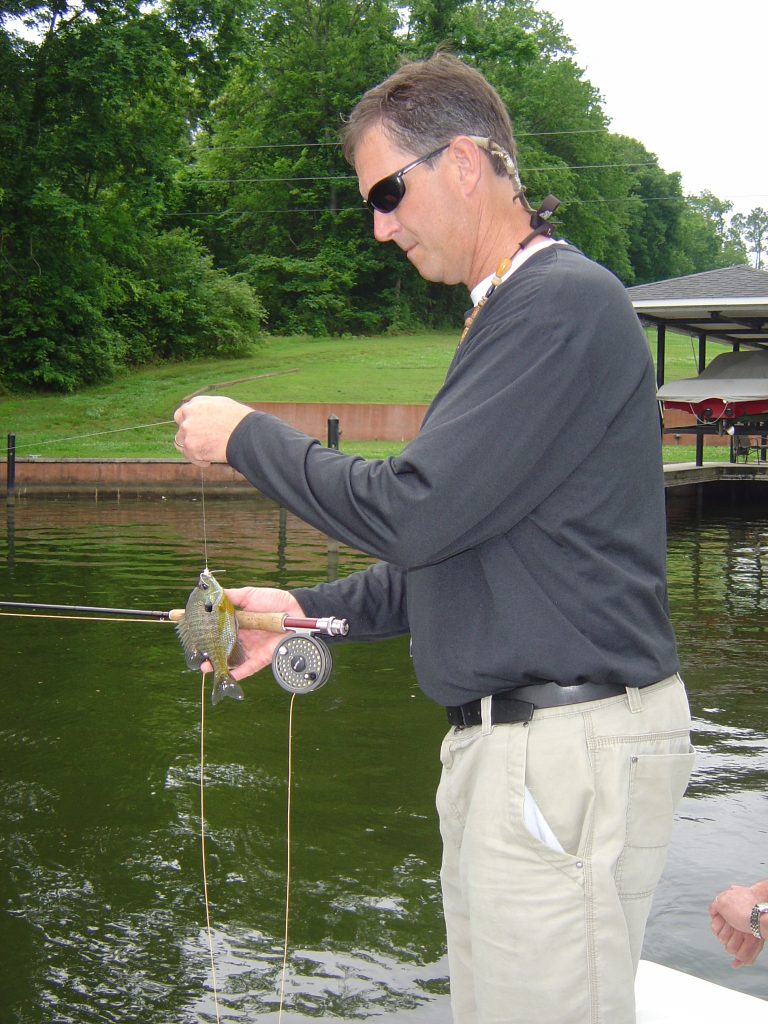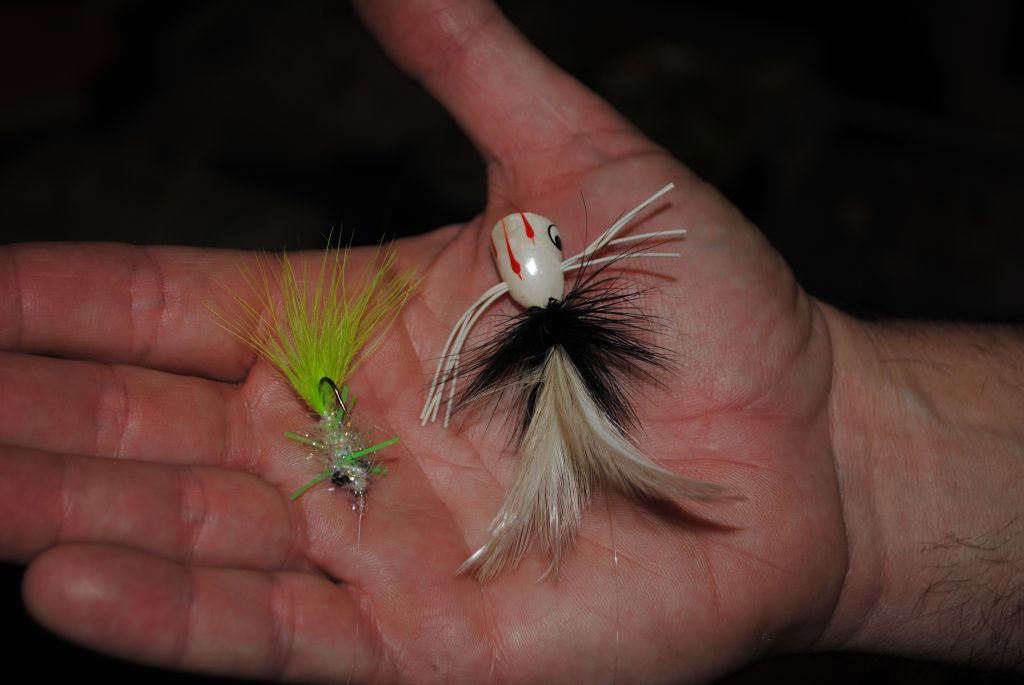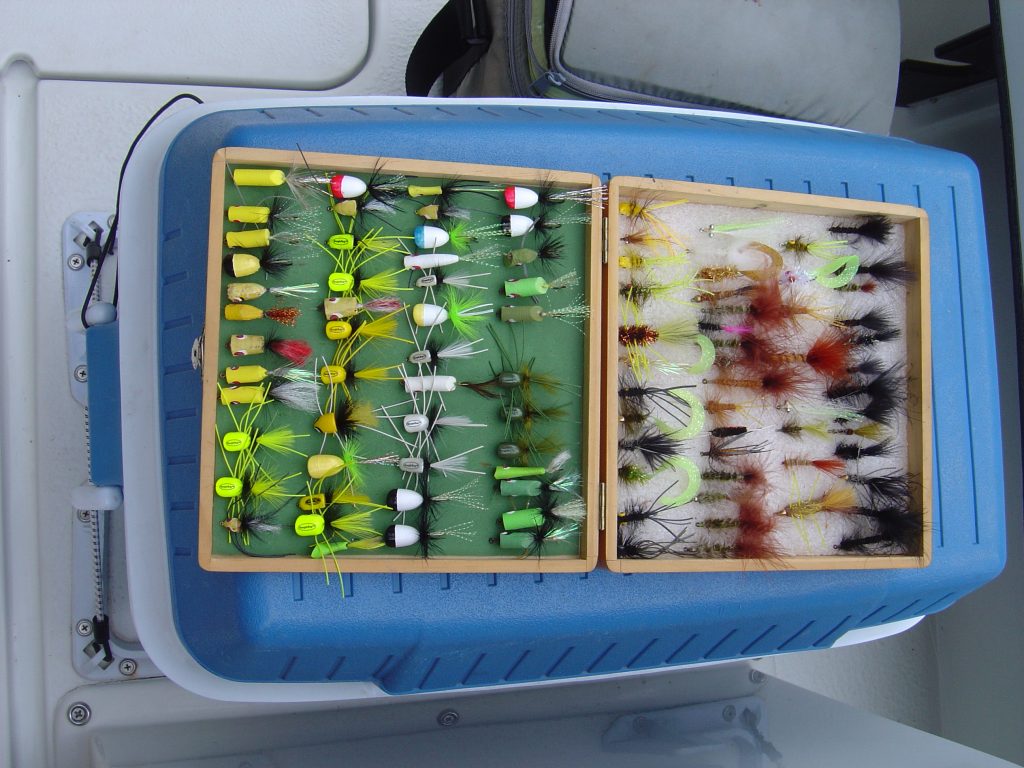Fly Fishing Poppers for Bream
Choosing a popping bug for bream seems like an easy proposition. Go to the local big box store or sporting goods outlet and buy what’s available. Everyone knows that bream will hit anything. Knowledgeable fly fishermen scoff at that naïve approach, however. They know, when fly fishing poppers, various complications that arise from going the cheap, easy route.
First of all, the selection is often limited in most stores simply because the demand is usually low. The quality of easy-to-get bugs also comes into question. Durability is a major concern and inexpensive bugs often survive only a few explosive strikes from bigger fish before being rendered unfishable.

North Alabama fly fishing guide Tony Cox suggests understanding the mood of fish is as important as choosing the right bug or fly.
Several questions come into play when considering the best possible presentation for bluegills and other bream species. What makes a good bug to entice fish, especially early in the year when they hug spawning beds? Just how important are size, shape, and color in the process of selecting the best popping bug for bream? Where do you find them? How to fish a popper? And are popping bugs even the best choice for bream at certain times of the year?
Fly fishing guru Tony Cox, who calls the Tennessee River home but catches fish on the fly from the trout streams of Arkansas and Tennessee to the Gulf of Mexico, offers a variety of options about what works well for bream from early in the season through the summer months.
Living near Florence, Cox spends much of his year pursuing bream and bass on Wilson and Pickwick lakes and their tributaries. He starts his pursuit of bream about the time they go on the bed in April or May.
Anglers farther south in Alabama might encounter spawning activity as early as late March with peak activity taking place in April.
Regardless of location or the exact timing, Cox said part of the challenge of choosing the best presentation involves understanding the mood of the fish.
“It all really depends on one thing, whether it’s choosing a popping bug or a steamer: how far are the fish willing to move to hit it?” Cox said.
Cox even goes as far as to suggest that choosing to fish a popping bug for pre-spawn bream and early spawners is probably not the best idea. While he revels in the flush of a bull bream on a bug as much as anyone, Cox said force-feeding a surface lure to spawning fish will probably result in a long day of casting practice with the occasional strike from small bream.
He further explains that bream on beds often have to move both horizontally and vertically through the water to reach a popping bug, especially the bigger fish, which typically spawn in slightly deeper water than their smaller counterparts.
“Early-season and spawning fish are generally just not willing to chase that much,” Cox said. “If you ever find them that want to chase, let me know. If I find them, I’m probably not going to tell you.”
He adds that he wants a lure, usually sub-surface, to target bream early in the spawning cycle. Cox owns an array of fly rods designed to match every fishing situation, so he is likely casting streamers and nymphs on a rig filled with a full sinking line as the spawn begins.
However, the average fly fisherman who owns a single rod, one likely spooled with a floating line, isn’t equipped for that practice. The solution, according to Cox, is a simple one and involves the trusty popping bug.
Fly Fishing Poppers: A Popper and a Dropper
The novice fly fisherman is probably most comfortable with a popping bug tied to his leader. But when the fish don’t want to eat on the surface, Cox suggests adding the dropper, a small weighted fly connected to the popper with a short leader. It’s a classic combination used in a variety of fly fishing situations and can significantly increase the number of strikes for fish holding tight on a bed.
Cox calls the two-lure combo the fly fishing equivalent of a drop shot rig employed by bass fishermen.

A popper and dropper rig is a deadly combination for pre-spawn and spawning bream.
“Take a good-sized popping bug, just about any old bug as long as it’s got a good hook,” he said. “It really doesn’t matter as long as it’s got good foam or cork and will float the fly. If it gets hit early in the year, it’s a happy accident.”
The leader can be anywhere from about 18 inches up to about three feet, depending on water depth. While the popping bug doesn’t have to be ornate – Cox said removing the legs helps eliminate “casting drama” – just use a dropper that tantalizes bream.
“Some of my bugs are old enough to drive,” Cox said. “They don’t look like much. But I want a fly (for the dropper) with a lot of movement. It’s kind of like playing with a kitten with a string. You want to entice them and then they will pounce.”
Cox said the combination demands some practice to present well, especially with a longer leader.
“You’re not just going to grip it and rip it,” he said. “Nobody is going to accuse you of looking like the guys from a River Runs Through It. I have been accused of looking like an octopus falling out of a tree (when casting a popper and dropper).
“It’s actually more of a lob than anything else.”
The good thing, Cox said, is that precision accuracy is not always required.
“Cast to get it there without creating a square knot in the air,” he said. “Cast beyond the target, strip it back slowly and allow the dropper to pendulum. Get it near the bed, stop it, and make a bedding fish nervous.”
Fly Fishing Poppers: Magical Transition
Given a choice, most fly fishermen would rather fool fish on the surface than catch them on a streamer or nymph. It’s part of the magic of fly fishing poppers.
Cox said he begins to experience that type of action each year sometime in late April or more likely May in north Alabama. The fish become more aggressive and look to the surface to eat. He said those bream are likely the first wave of spawners that have left the bed.
“It doesn’t all happen at once and that’s nature’s design to preserve the species,” Cox said. “Some are still on the bed and some are already in post-spawn.

Fished under a popping bug, a weighted fly that produces a lot of movement, is a good choice for early-season bream.
“When you happen to get them coming to the surface to eat, then you can always clip off the dropper and just use the popper. Usually, you’re going to find some of both, sometimes in the same area.”
Cox said he chooses a bigger popping bug, usually one with an open face, for early surface action. He wants to get the bream’s attention. Even then, the fish may be slow to come to a bug on top, and patience is required.
“Pop and stop,” Cox said, “a big pop and then a pause. Some of the old stories are true. You grow up reading about waiting for the rings to dissipate. There’s something to that.
“The fish are not going to chase 40 feet in April or May like they will in June. Early on, it’s pop and stop.”
Cox also said don’t be afraid to experiment with size. He frequently uses bugs that are bigger than average for bluegills. The bigger lures attract bigger bream and also appeal to bass as well. On other days, smaller bugs are the ticket.
Fly Fishing Poppers: Realism vs. Presentation
“I am much more of a ‘presentationist’. As long as I get the general shape and length, profile, and action, I will mess with shade, whether it’s light or dark, rather than with specific colors.”
Ultimately, Cox said he is usually not concerned with exactly “matching the hatch.” Size can be important. So can shape and color. However, he is more concerned with putting a realistic-looking presentation in front of a fish that causes it to react given its present mood.
“I’m not a realist when it comes to matching flies, and that gets me in trouble when I go speak to fly fishing clubs,” he said. “They want me to talk about how I exactly match a fly to what the fish are eating. There is something to do that, but it’s not me.
That doesn’t mean that Cox resorts to using just any type of popping bug for fly fishing. He is constantly refurbishing his old bugs and seeking out new ones. What does he look for in the best bug?
“That’s a hard question to answer,” he said. “It’s hard to find stuff locally. You have to do your homework online, and then you don’t actually know what you are getting until you put it to use.”
Fly Fishing Poppers: Commercial Success
When purchasing popping bugs, Cox has long favored an offering originally produced in the Birmingham area. The BoogleBug line has a strong following among fly rod enthusiasts. The bugs are pricey but well-constructed and effective. A single bug can withstand multiple days of fishing at times, and fishermen even extend their use by re-conditioning them.
“It’s really one of those comfort things, maybe confidence is the better word,” Cox said. “I still like the BoogleBug and use them at times. I really want to hate them, but I still buy a few. They make a really good bug.”

BoogleBug poppers will catch plenty of fish, especially when they begin to chase food on the surface just after the spawn.
Cox went on to suggest looking for quality bugs and flies in higher-end fly shops. The alternative is to scour the Internet on sites like breambugs.com. That site offers BoogleBugs and other higher-end bugs and flies. The price of a quality bug usually starts at about $3 and can easily be double that amount.
“I don’t know if there’s a single brand,” Cox said. “Mostly it’s what you have available and have confidence in fishing. If you have confidence in it, you’re probably going to have some success.
“I do buy some. I like to go to fly shops just to see what’s out there. I will admit, some of (the bugs) are sometimes made to catch fishermen more than to catch fish.”
Fly Fishing Poppers: Do It Yourself
Like many fly fishing addicts, Cox spends hours hovering over the vice, tying, and re-tying. He mentions an X-Acto knife as much as he mentions specific threads or other materials. The right combinations sometimes happen through experience and sometimes by accident.
Regardless of the outcome, Cox said the do-it-yourself approach can be productive, fulfilling, and produce some of the best fly fishing poppers. Cox experiments with a variety of shapes, sizes, and materials in building his flies and bugs.

Guide Tony Cox said most popping bug choices work if they reasonably duplicate the desired food and also if the fish are willing to move to hit them.
“You would be surprised what you can make with some cheap sheet foam from the dollar store,” he said. “There is something of an art to making a really good fly or bug, but the average person can build them well enough that they can catch fish all year long.”
Cox recommends using YouTube videos as tutorials and seeking out materials at a craft store like Hobby Lobby, which features more variety and a better selection than the average outlet. Of course, most fly shops offer supplies, but prices will also generally be higher.
Cox builds many of his baits with foam, using cork when it is available.
“Cork is old school, it’s expensive and not easy to find,” he said. “Many of the flies and bugs are made today out of some other type of material.”
Fly Fishing Poppers: Know the Fish
Cox re-emphasizes the importance of understanding the fish as much as choosing the right bug. “Bluegills can be tricky,” he said. “They are underrated as a fish that can kick your tail when they get particular.”
They may demand a popping bug with multiple wiggling rubber legs when they have their choice of mayflies all around them. At other times, fly fishing a bare-bones popper may result in unrestrained, repeated strikes.
“I’m sure there are bugs that are the absolute best for a given situation,” he said. “It’s equally important to know the mood of the fish. Is it the time of the year when their metabolism is high? Are they willing to chase?
“Then you can determine which bug to use and how to best present it.”
Full Disclosure: This post may include affiliate links. There’s no extra charge to our readers for using these.
